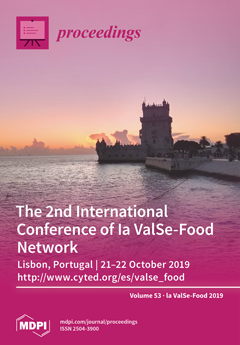Need Help?
Proceedings, 2020, la ValSe-Food 2019
The 2nd International Conference of Ia ValSe-Food Network
Lisbon, Portugal | 21–22 October 2019
Volume Editors:
Isabel Castanheira, National Health Institute Dr Ricardo Jorge, Portugal
Norma Sammán, Consejo Nacional de Investigaciones Científicas y Técnicas (CONICET), Argentina
Loreto Muñoz, Universidad Central de Chile, Chile
Claudia Monika Haros, Institute of Agrochemistry and Food Technology (IATA-CSIC), Spain
Printed Edition Available!
- Issues are regarded as officially published after their release is announced to the table of contents alert mailing list.
- You may sign up for e-mail alerts to receive table of contents of newly released issues.
- PDF is the official format for papers published in both, html and pdf forms. To view the papers in pdf format, click on the "PDF Full-text" link, and use the free Adobe Reader to open them.
Cover Story (view full-size image):
This volume summarizes the Proceedings of the II International Ia ValSe-Food, Development of Food Ingredients from Iberoamerican Ancestral Crops and V Symposium of Chia-Kink Network held in the
[...] Read more.
This volume summarizes the Proceedings of the II International Ia ValSe-Food, Development of Food Ingredients from Iberoamerican Ancestral Crops and V Symposium of Chia-Kink Network held in the National Institute of Health Doutor Ricardo Jorge (INSA), 20–21 October, Lisbon, Portugal. This volume gathers the recent investigations of la ValSe-Food Group on these valuable seeds and other crops and provides comprehensive and up-to-date knowledge within all the relevant fields of food science. It provides information on production and utilization, structure and chemical composition, paying special attention to carbohydrates, fibers, bioactive compounds, proteins, and lipids of kernels and other parts of the plants. It includes their process, various food products and applications, and the nutritional and health implications. We believe this volume will contribute to the increased utilization of the Iberoamerican Valuable Seeds in human nutrition.
Previous Issue
Next Issue
Issue View Metrics
Multiple requests from the same IP address are counted as one view.



